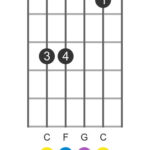Welcome to your comprehensive guide to the C#m7 Guitar Chord, a vital addition to any guitarist’s chord vocabulary. Building upon the foundation of minor seventh chords, this lesson will delve into the specifics of C#m7, exploring its construction, various voicings, and practical applications in music.
Understanding the C#m7 Chord: Theory Breakdown
Before diving into finger positions, let’s dissect the C#m7 chord from a music theory perspective. As you may know, a minor triad is formed using the root, the minor third, and the perfect fifth intervals. For a C# minor triad (C#m), the notes are C#, E, and G#.
To transform the C# minor triad into a C#m7 chord, we introduce the minor seventh interval above the root. In the key of C#, the minor seventh is B. Therefore, the notes comprising a C#m7 chord are:
- Root: C#
- Minor Third: E
- Perfect Fifth: G#
- Minor Seventh: B
Alt text: Musical notation showing the notes of a C sharp minor triad: C sharp, E, and G sharp.
Alt text: Musical notation illustrating the notes of a C sharp minor seventh chord: C sharp, E, G sharp, and B.
Exploring C#m7 Guitar Chord Voicings
While open chord shapes are often the starting point for guitarists, C#m7 is most effectively played using barre chord techniques. This allows for versatility and smooth transitions across the fretboard.
1. Barre Chord Shape (Based on Am7 shape):
One common way to play C#m7 is by adapting the Am7 barre chord shape. Start with a standard Am barre chord shape and move it up the neck until the root note (typically played by your index finger on the 6th string) is C#. This will be at the 4th fret.
- 4th Fret Barre: Index finger barring across all six strings at the 4th fret.
- 5th String, 6th Fret: Ring finger on the 5th string, 6th fret.
- 4th String, 6th Fret: Pinky finger on the 4th string, 6th fret.
- 3rd String, 5th Fret: Middle finger on the 3rd string, 5th fret.
This voicing provides a full and rich C#m7 sound, rooted on the 6th string.
Alt text: Guitar chord diagram showing F sharp minor 7 chord shape derived from F sharp minor in second position voicings.
2. Alternate Barre Chord Shape (Compact Voicing):
For a more compact and movable C#m7 voicing, particularly favored in genres like jazz, consider this shape:
- 9th Fret Barre: Index finger barring across five strings (1st to 5th string) at the 9th fret.
- 3rd String, 11th Fret: Ring finger on the 3rd string, 11th fret.
- 2nd String, 10th Fret: Middle finger on the 2nd string, 10th fret.
This voicing is higher up the neck and offers a brighter tone. The minor seventh (B) is doubled on the 2nd string, adding to the chord’s characteristic sound.
Alt text: Guitar chord diagram illustrating F sharp minor 7 chord shape played at the ninth fret.
C#m7 in Musical Context
The C#m7 chord, like other minor seventh chords, adds a touch of sophistication and melancholy to progressions. It frequently appears in:
- Jazz: Minor seventh chords are foundational in jazz harmony, providing rich and complex sounds.
- R&B and Soul: These genres often utilize minor seventh chords for their smooth and soulful qualities.
- Pop and Rock: While less common than major chords, C#m7 and other minor sevenths can add depth and emotion to pop and rock songs.
While the original article mentioned Earth, Wind & Fire’s “September” as an example using F#m7, C#m7, and Bm7, countless songs across genres feature C#m7. Exploring songs in minor keys or those with jazzy harmonies will reveal numerous instances of C#m7 in action.
Conclusion: Practice and Application
Mastering the C#m7 guitar chord expands your harmonic palette and unlocks new musical possibilities. By understanding its construction and practicing different voicings, you’ll be able to incorporate this versatile chord into your playing. Experiment with incorporating C#m7 into your chord progressions and explore songs that feature it to fully grasp its musical potential. Continue to explore minor seventh chords to further enhance your guitar skills and musical understanding.

